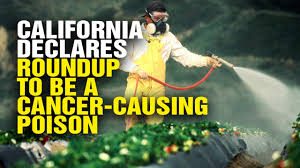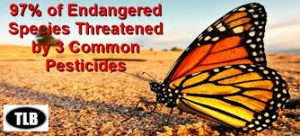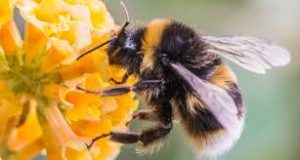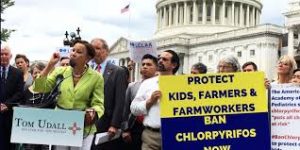03
May
Hawaii Bans Chlorpyrifos, First in the Nation
 (Beyond Pesticides, May 3, 2018)Â Hawaiiâs bill to ban the dangerous, neurotoxic pesticide, chlorpyrifos, passed its final hurdle this week in the state legislature. Governor David Ige is expected to readily sign SB3095 into law, in light of the unanimous support it received from lawmakers on both sides of the aisle. The statewide prohibition of chlorpyrifos will take effect beginning in January 2019. This legislative action marks the first time that any state in the country has passed an outright ban on the highly toxic organophosphate pesticide. While multiple scientific studies have determined that chlorpyrifos damages fetal brains and produces cognitive and behavioral dysfunctions, particularly in utero and in children, states have been slow to institute a complete prohibition, due to its widespread use in agriculture. Lawmakers in New Jersey and Maryland have recently tried unsuccessfully to pass similar bans. Hawaiiâs bill contains a caveat that allows the stateâs Department of Agriculture (DOA) to grant special permits for companies that argue that they need more time to phase-out chlorpyrifos, but that exemption will end at the close of 2022.
(Beyond Pesticides, May 3, 2018)Â Hawaiiâs bill to ban the dangerous, neurotoxic pesticide, chlorpyrifos, passed its final hurdle this week in the state legislature. Governor David Ige is expected to readily sign SB3095 into law, in light of the unanimous support it received from lawmakers on both sides of the aisle. The statewide prohibition of chlorpyrifos will take effect beginning in January 2019. This legislative action marks the first time that any state in the country has passed an outright ban on the highly toxic organophosphate pesticide. While multiple scientific studies have determined that chlorpyrifos damages fetal brains and produces cognitive and behavioral dysfunctions, particularly in utero and in children, states have been slow to institute a complete prohibition, due to its widespread use in agriculture. Lawmakers in New Jersey and Maryland have recently tried unsuccessfully to pass similar bans. Hawaiiâs bill contains a caveat that allows the stateâs Department of Agriculture (DOA) to grant special permits for companies that argue that they need more time to phase-out chlorpyrifos, but that exemption will end at the close of 2022.
The new law also requires restricted use pesticide (RUP) users to report to the Hawaiiâs DOA which ones they are applying on their land, crops, and in orchards, how much, and when and where they apply the chemicals. That information will be aggregated by county and publicly released in summary report on an annual basis. Such aggregated data enables researchers and policymakers to track yearly pesticide use trends by county and it can inform the development of public and environmental health protection policies.
But, according to Maui community activist, Autumn Ness, legislators substantially watered down the pesticide disclosure provision in SB3095, which was previously a robust, stand-alone bill. Instead of allowing public access to pesticide use data on an as-needed basis, which was what the advocates wanted, the bill requires DOA to only provide a summary of aggregated statistics on an annual basis. Since Hawaii is ground zero for chemical industry experimental testing of pesticides on cropland, the public has argued for the right-to-know what they are exposed to when pesticides drift off of test sites. Ms. Ness laments that this weak pesticide disclosure requirement will not automatically or easily allow communities to access site-specific data in instances where suspected acute exposures arise. Instead, the only way individuals or organizations may be able to view specific user data in a distinct location is to file a Universal Information Practices Act (UIPA) request, which legally requires an answer from DOA within 10 days but, in reality could take much longer, depending upon what is asked of the agency. This delay would not be helpful in cases of acute exposures.
In addition, the bill establishes a small schoolyard buffer zone, prohibiting companies from spraying highly toxic, RUPs within 100 feet of schools while they are in session. Similar to what happened with respect to the pesticide use disclosure provision, a strong, stand-alone pesticide buffer zone bill was originally introduced. It was added to the chlorpyrifos ban bill and severely weakened. The original provision was modeled on Californiaâs pesticide buffer zone law. Californiaâs law requires a quarter-mile pesticide exclusion zone around schools when they are in session, versus the 100 foot exclusion zone contained in the Hawaii bill. The only real similarities between the two is that they allow pesticides to be used near schools when they are not in session. In both cases, this could result in pesticides being sprayed during sporting events or other outdoor community activities that often take place on school campuses after hours.
Public pressure to prohibit chlorpyrifos has mounted in recent years due to increasing scientific evidence, which shows that even at low levels of exposure to pregnant women results in impaired learning, change in brain functions, and alter thyroid levels of children into adulthood. Females are especially at risk. A study conducted by the Columbia University Center for Childrenâs Environmental Health (CCCEH) found that chlorpyrifos in umbilical cord blood samples corresponded with a decrease in the psychomotor and mental development in three-year olds. Additional data collected by CCCEH researchers demonstrated that children exposed to high levels of chlorpyrifos experience developmental delays, attention deficit, hyperactivity, as well as other pervasive developmental disorders.
Knowledge of these gross impacts on developing fetuses and children motivated community members across the Hawaiian Islands to speak out against the use of chlorpyrifos and other pesticides near schools and to educate state lawmakers about their dangers. It took several years to create a groundswell of public support for the ban with people regularly speaking out against chlorpyrifos and other RUPs. Multiple court battles ensued, as did a relentless, high profile public campaign, backed by strong and unyielding leadership from key legislators.
Prior to the state legislatureâs vote, advocates of the ban brought scientists and doctors to the Islands to discuss their research on high and low level exposures to noxious pesticides, describing in graphic detail the effects on fetuses, developing children, and adults. The Hawaii Reporter notes that, âDoctors wrote and spoke of their first-hand encounters with various health conditions known to be linked to pesticide exposure in large studies. Several physicians last year co-signed an appeal to the governor urging a ban on chlorpyrifos based on their concerns. They cited the findings of the American Academy of Pediatrics (AAP) who noted that the risk to infant and childrenâs health and development is unambiguous.â
This quest for advancing public health in Hawaii above economic interests is far from over, and statewide health and environmental advocates do not plan to wallow in their victory for long. In fact, this week, in the face of strong public pressure, the state legislature passed a SB2571, which bans the sale and distribution of sunscreens containing oxybenzone and octinoxate. The chemicals are toxic to developing coral reefs and increase the coralâs susceptibility to bleaching. They also have been found to damage DNA in adults, according to study of the chemicalâs effect on reefs in Hawaii and the U.S. Virgin Islands. Once the Governor signs the bill, which is expected, it will take effect on January 1, 2021. And, again, Hawaii will lead the nation as the first state to ban toxic chemicals in sunscreen.
To oppose the continued allowance of chlorpyrifos and other noxious pesticides in your community, write or call your US Congressional Representative. Urge them to support the Protect Children, Farmers, and Farmworkers from Nerve Agent Pesticides Act of 2017 to safeguard schools, neighborhoods, and workplaces from the unnecessary exposure to this neurotoxin. Learn more about the fate, effects, and impacts of pesticides, including chlorpyrifos, by visiting Beyond Pesticidesâ Pesticide-Induced Diseases Database. Also, consult Beyond Pesticidesâ factsheet Children and Pesticides Donât Mix, which cites peer-reviewed scientific literature on the health effects of pesticides.
All unattributed positions and opinions in this piece are those of Beyond Pesticides.
Sources:Â Civil Beat; Hawaii Reporter; Beyond Pesticides; Huffington Post;









 (Beyond Pesticides, May 2, 2018) Granola, cereal, and wheat crackers all contain âa fair amountâ of glyphosate, the herbicide in Monsantoâs popular Roundup, according to internal emails from the Food and Drug Administration (FDA). Although the results of these tests have not been formally released, FDA had stated it will be conducting tests for glyphosate in food. Previous reports have detailed the presence of glyphosate, the chemical classified as a âprobable carcinogen,â in a wide range of foods and in peopleâs bodies.
(Beyond Pesticides, May 2, 2018) Granola, cereal, and wheat crackers all contain âa fair amountâ of glyphosate, the herbicide in Monsantoâs popular Roundup, according to internal emails from the Food and Drug Administration (FDA). Although the results of these tests have not been formally released, FDA had stated it will be conducting tests for glyphosate in food. Previous reports have detailed the presence of glyphosate, the chemical classified as a âprobable carcinogen,â in a wide range of foods and in peopleâs bodies. (Beyond Pesticides, May 1, 2018) On April 27, 2018, European Union (EU) member states backed a proposal to further restrict uses of bee-toxic neonicotinoids finding the pesticidesâ outdoor uses harm bees. These restrictions go beyond those already put in place in 2013, and now all outdoor uses of clothianidin, imidacloprid, and thiamethoxam will be banned. Uses will only be allowed in permanent greenhouses where contact with bees is not expected. This historic move in Europe comes as the U.S. Environmental Protection Agency (EPA) still drags its feet on finding neonicotinoids are too toxic for bees and other organisms and bans their use.
(Beyond Pesticides, May 1, 2018) On April 27, 2018, European Union (EU) member states backed a proposal to further restrict uses of bee-toxic neonicotinoids finding the pesticidesâ outdoor uses harm bees. These restrictions go beyond those already put in place in 2013, and now all outdoor uses of clothianidin, imidacloprid, and thiamethoxam will be banned. Uses will only be allowed in permanent greenhouses where contact with bees is not expected. This historic move in Europe comes as the U.S. Environmental Protection Agency (EPA) still drags its feet on finding neonicotinoids are too toxic for bees and other organisms and bans their use.
 (Beyond Pesticides, April 27, 2018)Â Â After more than five years of intensive negotiations, European Members of Parliament (MEP) overwhelmingly passed the long-anticipated, new
(Beyond Pesticides, April 27, 2018)Â Â After more than five years of intensive negotiations, European Members of Parliament (MEP) overwhelmingly passed the long-anticipated, new  (Beyond Pesticides, April 26, 2018)Â Each year, the
(Beyond Pesticides, April 26, 2018)Â Each year, the  (Beyond Pesticides, April 25, 2018)Â A class-action lawsuit against two manufacturers of neonicotinoid insecticides is moving ahead in Quebec, Canada after an appeal to block the case by the Canadian government and the chemical companies, Bayer and Syngenta, was dismissed. In February 2018, the case, brought by a beekeeper, was allowed to proceed to trial by the Quebec Superior Court.
(Beyond Pesticides, April 25, 2018)Â A class-action lawsuit against two manufacturers of neonicotinoid insecticides is moving ahead in Quebec, Canada after an appeal to block the case by the Canadian government and the chemical companies, Bayer and Syngenta, was dismissed. In February 2018, the case, brought by a beekeeper, was allowed to proceed to trial by the Quebec Superior Court. (Beyond Pesticides, April, 24, 2018) On April 19, 2018, an Appellate Court in California sided with the State of California, affirming that Monsanto’s glyphosate can be listed as a probable carcinogen under the state’s Proposition 65 and rejecting Monsantoâs challenge to law. The state will not only move ahead with warning labels on products that contain glyphosate but also prohibit discharge of the pesticide into public waterways.
(Beyond Pesticides, April, 24, 2018) On April 19, 2018, an Appellate Court in California sided with the State of California, affirming that Monsanto’s glyphosate can be listed as a probable carcinogen under the state’s Proposition 65 and rejecting Monsantoâs challenge to law. The state will not only move ahead with warning labels on products that contain glyphosate but also prohibit discharge of the pesticide into public waterways. (Beyond Pesticides, April 20, 2018) There is an extraordinary attack on local community rights to protect people and the environment from pesticides in the Republican Farm Bill, passed by the Agriculture Committee in the U.S. House of Representatives on April 18 on a straight party line vote. The language inserted in the Farm Bill amends the federal pesticide law with a provision that prohibits local governments from restricting pesticide use on private property within their jurisdictions. Local laws in two states, Maine and Maryland, will be overturned with final passage of this law in the U.S. House and Senate. In those 43 states that forbid local pesticide laws by state law, future reconsideration of this prohibition, pushed by the chemical and pest management industry, will be foreclosed. Local laws protecting the environment and public health have historically emerged out of local governments, with laws related to recycling, smoking, pet waste, building codes, and zoning.
(Beyond Pesticides, April 20, 2018) There is an extraordinary attack on local community rights to protect people and the environment from pesticides in the Republican Farm Bill, passed by the Agriculture Committee in the U.S. House of Representatives on April 18 on a straight party line vote. The language inserted in the Farm Bill amends the federal pesticide law with a provision that prohibits local governments from restricting pesticide use on private property within their jurisdictions. Local laws in two states, Maine and Maryland, will be overturned with final passage of this law in the U.S. House and Senate. In those 43 states that forbid local pesticide laws by state law, future reconsideration of this prohibition, pushed by the chemical and pest management industry, will be foreclosed. Local laws protecting the environment and public health have historically emerged out of local governments, with laws related to recycling, smoking, pet waste, building codes, and zoning. (Beyond Pesticides, April 19, 2018)Â With the passage yesterday of the Republican amendments to the 2018 Farm Bill,Â
(Beyond Pesticides, April 19, 2018) With the passage yesterday of the Republican amendments to the 2018 Farm Bill,  (Beyond Pesticides, April 18, 2018)Â
(Beyond Pesticides, April 18, 2018)Â  (Beyond Pesticides, April 17, 2018) In a case that appalled the nation, the U.S. Justice Department finally last week secured an indictment against an applicator who illegally applied a fumigant at a U.S. Virgin Island resort,
(Beyond Pesticides, April 17, 2018) In a case that appalled the nation, the U.S. Justice Department finally last week secured an indictment against an applicator who illegally applied a fumigant at a U.S. Virgin Island resort,  (Beyond Pesticides, April 16, 2018)Â Ethics scandals pile up regarding Environmental Protection Agency Administrator Scott Pruittâs failure to do his job, leading to the
(Beyond Pesticides, April 16, 2018)Â Ethics scandals pile up regarding Environmental Protection Agency Administrator Scott Pruittâs failure to do his job, leading to the  (Beyond Pesticides, April 13, 2018) Hawaii is poised to become the first state in the nation to prohibit the use of pesticides containing the developmental neurotoxicant, chlorpyrifos.
(Beyond Pesticides, April 13, 2018) Hawaii is poised to become the first state in the nation to prohibit the use of pesticides containing the developmental neurotoxicant, chlorpyrifos.  (Beyond Pesticides, April 12, 2018) The Justice Department will allow two notorious agrichemical corporations, Bayer and Monsanto, to merge, according to reports published earlier this week. Despite
(Beyond Pesticides, April 12, 2018) The Justice Department will allow two notorious agrichemical corporations, Bayer and Monsanto, to merge, according to reports published earlier this week. Despite  (Beyond Pesticides, April 11, 2018) The request by shellfish growers in Washington State to apply the neonicotinoid insecticide, imidacloprid, on oyster and clams beds to control native burrowing shrimp was denied by the Department of Ecology (Ecology) after it determined âenvironmental harm from this neonicotinoid pesticide would be too great.â Concerned resident and environmental advocates have been opposed to the proposed use citing harms to aquatic life including fish habitat, and long-term ecological damage.
(Beyond Pesticides, April 11, 2018) The request by shellfish growers in Washington State to apply the neonicotinoid insecticide, imidacloprid, on oyster and clams beds to control native burrowing shrimp was denied by the Department of Ecology (Ecology) after it determined âenvironmental harm from this neonicotinoid pesticide would be too great.â Concerned resident and environmental advocates have been opposed to the proposed use citing harms to aquatic life including fish habitat, and long-term ecological damage. (Beyond Pesticides, April 10, 2018) Current strategies aimed at managing herbicide resistant weeds in agriculture are not effective and may exacerbate weed problems, according to
(Beyond Pesticides, April 10, 2018) Current strategies aimed at managing herbicide resistant weeds in agriculture are not effective and may exacerbate weed problems, according to  (Beyond Pesticides, April 9, 2018)Â A new international study finds that the unsustainable exploitation of natural resources worldwide has reached critical proportions, causing biodiversity loss and land degradation that threaten the food and water security of an estimated 3.2 billion people. Congress must act for the U.S. to become a signatory to the United Nations Convention on Biodiversity, joining the global community in working to develop and implement solutions to the biodiversity crisis.
(Beyond Pesticides, April 9, 2018)Â A new international study finds that the unsustainable exploitation of natural resources worldwide has reached critical proportions, causing biodiversity loss and land degradation that threaten the food and water security of an estimated 3.2 billion people. Congress must act for the U.S. to become a signatory to the United Nations Convention on Biodiversity, joining the global community in working to develop and implement solutions to the biodiversity crisis. (Beyond Pesticides, April 6, 2018)Â Scott Pruitt, Administrator of the U.S. Environmental Protection Agency (EPA), is getting plenty of attention for what the public and some members of Congress see as his spendthrift and potentially corrupt behaviors since taking office in early 2017.
(Beyond Pesticides, April 6, 2018)Â Scott Pruitt, Administrator of the U.S. Environmental Protection Agency (EPA), is getting plenty of attention for what the public and some members of Congress see as his spendthrift and potentially corrupt behaviors since taking office in early 2017.  (Beyond Pesticides, April 5, 2018) An industry-backed attempt to enact pesticide preemption in the state of Maine is officially over after bill
(Beyond Pesticides, April 5, 2018) An industry-backed attempt to enact pesticide preemption in the state of Maine is officially over after bill  (Beyond Pesticides, April 4, 2018) In late March, the Missouri Department of Agriculture hosted a public hearing to discuss a proposed emergency rule restricting the sale and use of the herbicides dicamba and 2,4-D â which are known for their ability to drift off-site and damage sensitive crops. The emergency rule was introduced to prevent off-label use of specific dicamba or 2,4-D products. Thus far, dicamba is responsible for damaging approximately 325,000 acres of soybeans in the state last year.
(Beyond Pesticides, April 4, 2018) In late March, the Missouri Department of Agriculture hosted a public hearing to discuss a proposed emergency rule restricting the sale and use of the herbicides dicamba and 2,4-D â which are known for their ability to drift off-site and damage sensitive crops. The emergency rule was introduced to prevent off-label use of specific dicamba or 2,4-D products. Thus far, dicamba is responsible for damaging approximately 325,000 acres of soybeans in the state last year. (Beyond Pesticides, April 3, 2018) Humans’ unsustainable exploitation of natural resources, worldwide, has reached critical proportions, threatening the ability of an estimated 3.2 billion people to have food and water security, according to a new international study. The
(Beyond Pesticides, April 3, 2018)Â Humans’ unsustainable exploitation of natural resources, worldwide, has reached critical proportions, threatening the ability of an estimated 3.2 billion people to have food and water security, according to a new international study. The 
